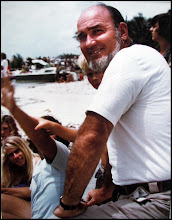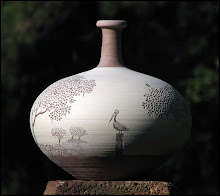 Today I opened the mailbox and found a copy of Brad Neat's first book: Tales from the Reef. It's a book about staying safe while diving, but it's not a re-hash of the kinds of things dished out in modern SCUBA diving certification courses. This is the distilled wisdom that comes from Brad having spent about 40 years hauling pilgrams out to the reefs and bringing them back again, often despite themselves. The book is being passed around the Keys waterfront, where many of the dive boat operators are making it mandatory reading for their crews and aspiring dive-masters.
Today I opened the mailbox and found a copy of Brad Neat's first book: Tales from the Reef. It's a book about staying safe while diving, but it's not a re-hash of the kinds of things dished out in modern SCUBA diving certification courses. This is the distilled wisdom that comes from Brad having spent about 40 years hauling pilgrams out to the reefs and bringing them back again, often despite themselves. The book is being passed around the Keys waterfront, where many of the dive boat operators are making it mandatory reading for their crews and aspiring dive-masters.As it should be. You can buy it from amazon.com: http://www.amazon.com/Tales-From-the-Reef/dp/0982310501
My son is an ocean lifeguard and occasional diver and I had ordered the book for his 17th birthday that's coming up. In the meantime, I've had to read it very carefully so that it will still appear fresh and unread when Hayden opens the gift wrapping next week. I almost ruined everything by starting it during dinner, and snorting out my beverage with the laughter that came when I got to the end of the very first Tale from the Reef: "Man's best Friend." I won't spoil it, but at some point, we've all felt like the pooch in the story. We just seldom have the wisdom that the pooch had: knowing when it's time to bail out.
Brad wrote a nice note to Hayden on the inside cover. At the risk of some grievous copyright infringement, I have to share the first paragraph of Brad's Acknowledgement page, which visitors to this little blogsite will have a special appreciation for:
"I wouldn't have even ended up in the Florida Keys if it wasn't for the vision of Ron Mahan who started a summer camp and gave thousands of kids their first taste of life on the water. I was lucky enough to be hired as a counselor and Ron's concept of "learn by doing" has been a constant thread in my life. He had the courage to give you the tools, point you in the right direction, and then stand back and watch while you either succeeded or crashed. After the occasional crash, he would pick you up, dust you off, and then with a chuckle of encouragement, send you off again. He was forever generous with his praise,time, equipment, or anything else that you could use. Thanks again Uncle Ron and thanks to the others that all had some influence in my life: Carl Gage, Bobby Klein, Gene Geh, Big Bob Vaughn, Andy Massimino, Coach Davis, Bob Lewis, and Bob Bigelow, among others."
That is some kind of list.
This photo is about ten years old. Brad was driving that amphib down the bay side one summer afternoon, and dropped into Island Bay Resort (ex-Fish Camp) to pick up Hayden so he could ride along on the next leg that ended near Marathon. Hayden wore that big smile for about a week after that. Brad's next book can use this picture at the beginning to illustrate the way he came by his nickname: "What Legs?"
The brief little bio of Brad on the back cover is just a tease for his next book. I think he should call it: "Being Brad Neat." He should write it because he obviously has so many more Tales of the Reef to tell.
In addition to an acknowledgement to Carl Gage, Brad has a brief discussion about the end of the era of wooden dive boats. In Brad's next book, Carl Gage and his wooden dive boats probably rate a whole chapter. Gage was a larger-than-life character who helped kickstart the Key Largo diveboat business when there wasn't much of a blueprint to follow. In the 1960's and 70's, just about every diver from Miami and most every serious dive tourist in the United States had been out on Carl Gage's flagship dive boat, the Reef Queen. Brad worked for Carl and ran the Reef Queen for a number of years.
Fish Campers got to work around Carl Gage because we chartered his overflow boat for the summers. It was a tired but really salty carolina boat called the Henrietta. At six knots, there was a lot of time for camaraderie going back and forth to the reef from the marina in Key Largo. There was also a time after some rough weather when the low guys on the Fish Camp totem-pole had to take turns sleeping on the Henrietta. You were there to either sleep on a cushion on the saloon floor, or else sleep on the berth with one arm dangling over the edge onto the saloon floor. When the leaking bilge water got up that high it would wake you up. After an hour or so of vigorous sex with the manual bilge pump, you could go back to sleep until you woke to the sound of a bus load of dive gear being thrown into the cockpit from the dock. Never even got a morning donut, just "Hey, dude, catch this. It's got my mask in it."Gage was fascinating. He helped build some of the cool little submarines used in the epic good-guy / bad-guy underwater battle scene of the James Bond Thunderball movie (1966). http://www.youtube.com/watch?v=DpntIGdBsnI He kept a couple of the mini-subs in the dive shop as novelties. Gage was a former Marine Corp officer, but despite his really gruff and rough persona, he had a very delicate and sensitive talent for underwater photography. Gage (no one had the cojones to call him "Old Chrome Dome" to his face) flew a light twin out of the old Key Largo Airport (gone now) and mapped out a lot of the reefs by aerial photography.
Like a lot of kids, I showed up every summer with a good deal of "accessories" among my dive gear. These were things that I knew to be essential: a depth gage (we never went deeper than 35 feet), a great big dive watch (we never approached decompression limits with single 72 cu.in. tanks,) and of course, the knife. You know, for the occasional Sea Hunt battle when you might need to cut through a guy's double hose regulator.
You never felt so stupid as when Carl Gage looked you over, shook his head, and said "Okay, Hero, pick up the trash in the back of the boat." All the paying customers were "Pilgrams," and a schlep loaded down with useless equipment was a "Hero."
Some time in the 1970's, Carl Gage sold his dive operation and moved to California to take up his next passion: he built hot-air baloons. Note the dive flag motif, and his advertising label around the bottom. These photos are from one of Carl's California friends, photographer Michael Hogan, now living in Sydney, Austrailia.
Michael reports that Carl passed away in 2002. I hope someone saved all of his underwater photographs. As often goes with the territory of folks who live large, Carl Gage never married and left no family.

-c1982-(3)%5B1%5D.JPG)
-c1982-(10)%5B1%5D.JPG)




